 |
 |
|
 |
 |
|
If you plan on caravanning as a family, the options are to go for seats that convert to beds, or a mixture of this and a permanent double bed or single beds. Touring caravans with permanently fixed beds for a whole family aren’t available.
A recent innovation is 3-tier children’s bunk beds which increase the sleeping capacity without taking up extra floor space - though at the expense of headroom between the bunks.
|
|
|
|
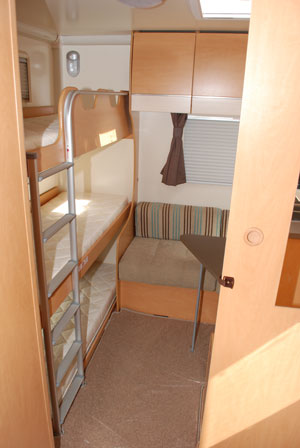 |
|
Three-tier bunks are a space-saving idea for a family caravan.
|
|
|
|
Look at bed/bunk sizes whilst choosing your caravan and ensure they will cope with your FUTURE needs as well as your current ones. Be mindful that when a manufacturer claims a caravan to be a six-berth, it most likely means two adults and four children - NOT six adults.
By no means least, check how comfortable the various beds are. One of the big benefits of caravanning is that you should get a good night’s sleep because, whenever you go away, you sleep in a bed you are familiar with. That’s not much use if its uncomfortable!
How Tall Are You?
Having checked the beds for size, also check that the headroom available in the caravan itself will be enough for the tallest person that will use it. Be mindful that some caravans have more headroom in the middle than at the ends
|
|
|
|
A Room For the Kids
Some caravans have partitions. Sleeping in a room of your own is good for privacy and a partition in the right place also enables you to be relaxing in the lounge whilst the children are playing in an entirely separate area of the caravan. If this is important to you, check it out before you buy.
Finding Extra Room
Although your towcar capacity and budget may dictate the size of caravan you can buy, you can provide flexible extra space by adding an awning. These come in a wide variety of designs and sizes.
In the region of £120 will buy you a porch awning with a floor area around 2 metres square. You’ll find this a boon for storing all manner of things and as a place to change out of your wet gear and wellies on rainy days.
|
|
|
|
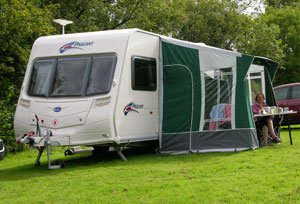 |
|
|
|
At the other extreme there are sturdy all- weather full awnings costing over £1,000 although, for £200 - £300 you can often pick up a second-hand one to fit your caravan.
|
|
|
 |
|
|
 |
Visit a Major Dealership
|
 |
 |
|
When you’ve considered the advice given in this article, note down all the features you think would make up your ideal caravan.
Then visit a large caravan dealer who has plenty of new and second-hand caravans in stock.
Spend an hour or two walking through the different models, sizes and layouts and imagine doing the normal things you would be doing during the course of each day.
Is it easy to reach the kitchen cupboards? Are the mains socket outlets in convenient places for the things you’ll want to plug in? Do the heater and water heater work on dual-fuel?
Walk around each area of all the caravans you think might meet your needs:-
- Does the washroom have enough room to dress and dry the kids?
- Is the shower big enough?
- Is there enough food preparation area in the kitchen?
- Is there an oven?
- Is the hob dual-fuel? How many burners does it have?
- Is the fridge big enough and is there a freezer compartment?
|
|
 |
 |
 |
- Are the beds comfortable and easy to make up?
- Can you really cope with that cutaway in the fixed double bed?
- Is there a separate area for the children to play?
- How comfortable are the lounge seats? How easily do they hinge up to give storage access?
- Is there enough room to seat all of the family around the table?
- Is there enough headroom? Is it the same all through the caravan?
- Are the beds long/wide enough for their respective occupants? Will they cope with growing children?
- Is there enough height between bunk beds?
- Is there an external plug point and/or gas barbecue offtake?
- Is there a spare wheel?
- Is there a stabiliser fitted as standard equipment?
|
|
|
These are just examples as the ACTUAL points you need to check out will be personal to YOU.
Only in this way can you judge which caravans would meet your needs and which ones wouldn’t. Time spent checking out at this stage will save disappointment once you have bought and ensure you buy a caravan that will serve you well for many years.
|
|
|
|
|
 |
 |
 |
 |
 |
|
Use one of these for storage, as a sun lounge or, if you buy one with sleeping compartments, it can even provide extra bedrooms.
Be mindful that full awnings (unlike porch awnings) come in sizes to match specific caravans. You need to know the length from the ground, up through the awning rail and back down to the ground on the other side (in centimetres).
Television?
Some say facilities for watching TV are totally irrelevant to caravanning, whereas others say they are essential. Certainly on rainy days and cold winter evenings a television can be very useful.
Look for the availability of a TV aerial socket plus a suitably-placed mains socket and shelf/surface to stand the television on.
|
|
|
|
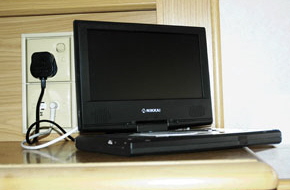 |
|
|
Check that the TV aerial socket is conveniently placed and that there is also a handy mains socket.
|
|
|
|
Also check what type of aerial comes with the caravan as standard. Older caravans may not have an aerial at all, or may have an older circular type aerial rather than a much better directional aerial that most caravan manufacturers fit nowadays.
On the Technical Side.
Finally, there are a few things to check outside the caravan. The most important of these is whether it will be supplied with a spare wheel.
Taking to the road without one of these(with properly inflated tyre) is madness so, if a spare wheel doesn’t come as standard you’ll need to buy one.
Next consider the tow hitch. Most new caravans these days come with a tow hitch that incorporates a stabiliser. However, older caravans and some entry-level new caravans are fitted with a standard hitch without a stabiliser.
|
|
|
 |
 |
 |
|
A stabiliser hitch incorporates clutch plates which grab the towball tightly to minimise the effect of snaking whilst you are driving along.
Stabiliser hitches are available for retro-fit, but they are expensive so its best to buy a caravan that already has one fitted. Alternatively, you can use a standard hitch in conjuntion with a leaf-type stabiliser, which is available as an accessory. This also works on a friction principle and can be used in conjunction with fixed towballs, but not with all detachable ones.
Finally, check whether the caravan has a motorised mover fitted. These devices enable you to effortlessly move the caravan around whilst it is separated from the towcar. They are ideal for parking the caravan on a driveway (especially a sloping one!) and for final positioning of the caravan on-site. They can also be used to exactly position the caravan over the car’s towball when hitching up.
|
|
|
|
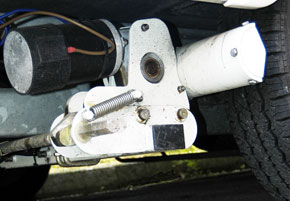 |
|
With a motorised mover its easy and effortless to move the caravan around whilst unhitched from the tow vehicle.
|
|
|
Movers comprise motorised friction cylinders that can be brought into contact with the caravan’s wheels. With these engaged, you simply press buttons on a remote controller (a bit like changing channels on a television) and the caravan moves forwards, backwards or turns in whichever direction you want.
Caravan manufacturers don’t tend to fit movers as part of the standard specification, but dealers will sometimes fit one as a sales incentive, especially on second-hand caravans.
Get Out There and Enjoy Yourself
If you follow the advice in this article you will end up with a caravan as closely matched to your needs as it can possibly be. All that’s left to do, then, is to get out there and enjoy the caravanning lifestyle
|
|
|
|
 |
|
|
 |
|
Buying a Second-hand Caravan
|
 |
 |
|
 |
|
The advice in other parts of this article applies to both new and second-hand caravans. When buying second-hand, though, there are additional points to consider.
Dealer or Private Purchase?
You may find a bargain buying privately, but you’ve virtually no legal come-back if things go wrong. Be particularly on the lookout for water ingress (it can be expensive to rectify).
|
|
|
|
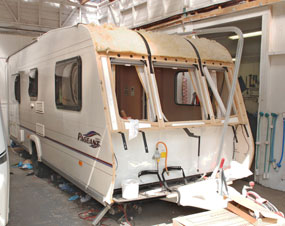 |
|
|
Water ingress in a caravan can be costly to rectify.
|
|
|
|
At very least:-
- Ask for proof of ownership
- Only buy from someone selling from their own home or a bona-fide storage facility.
Buying from a dealer offers greater protection under consumer legislation as the caravan must be ‘of satisfactory quality’ and ‘fit for the purpose as described’. Of course, some dealers are better than others and there’s no better way of finding a reputable one than speaking to other caravanners.
A dealer should be willing to put the caravan through a service and a full safety check before you take delivery. Except on the oldest of caravans, they should also offer a guarantee (check the small print to find out what it covers).
Check the history
Whether buying privately or through a dealer, ask for evidence of the caravan’s service history. An annual service by a National Caravan Council approved workshop is proof it has been looked after.
|
|
|
|
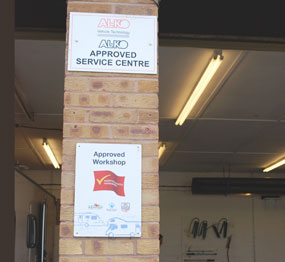 |
|
|
Proof of regular servicing by an ‘Approved Workshop’ is evidence the caravan has been looked after.
|
|
|
Note down the 17 digit CRiS number (etched into the windows) so you can check whether the caravan has been stolen or is an insurance write-off.
|
|
|
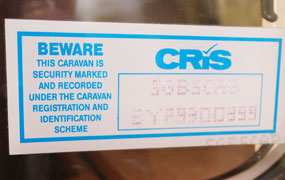 |
|
|
 |
 |
 |
 |
|
Check Out the Caravan
Go through the motions of using the caravan to check that everything works:-
- Sit on the seats/beds. Do they still offer good support or have they seen better days?
- Do the cupboard and door catches and hinges work?
- Are there any areas of floor that feel ‘spongy’? Delamination can be costly to put right.
- Ask to see the heating system working both on gas and electric (if applicable).
- Ask to see the water system working. Check the flow (on both hot and cold settings) at ALL taps and at the shower head in its highest position.
- Ask to see the water heating system working (on both gas and electric if applicable).
- Check that the fridge gets cold (on both gas and mains electric).
- Do all cooking appliances work?
- Do all the lights and mains sockets work?
- Outside, check aluminium panels for signs of perforation
- Check for cracking in GRP or ABS end panels. They are expensive to replace. ABS is difficult to repair.
- Check that the jockey wheel and steadies wind down smoothly.
|
|
|
|
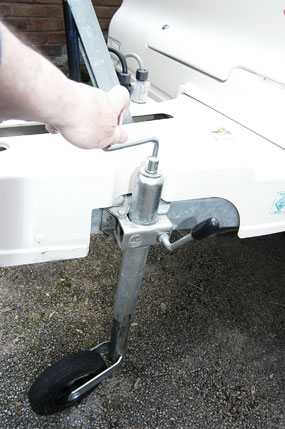 |
|
|
Check that the jockey wheel and corner steadies wind smoothly. Ask for them to be lubricated or replaced if necessary.
|
|
|
|
- Check the stabiliser (if fitted) by ensuring it tightly grips a towball (not necessarily fitted to a vehicle).
|
|
|
|
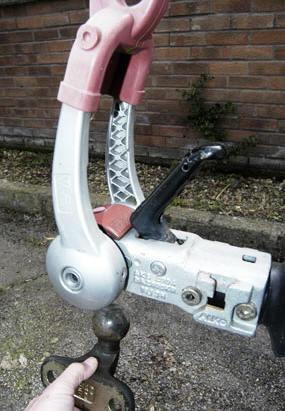 |
|
|
|
Check the stabiliser (if fitted) by checking that it tightly grips a spare towball.
|
|
 |
 |
 |
 |
|
- If a mover is fitted, does it work?
- Check the chassis. If it shows signs of damage or rust, DON’T BUY. Be extra vigilant for caravans that have been kept by the coast.
|
|
|
|
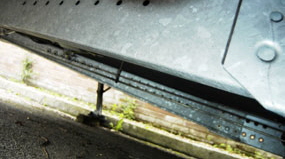 |
|
|
Check the chassis carefully.
|
|
|
|
- If there’s no documented service history, beware. AT VERY LEAST get the caravan checked over by a qualified technician. He will have a damp meter - the best time for the caravan to be checked over is whilst its raining.
- Is there a spare wheel?
- How old are the tyres? Even if the tread is good, you should not use tyres more than 5 years old (7 years at the absolute outside). The last 4 digits of the 12 digit DOT Code on the tyre rim tell you the age of the tyre - for example 4807 means the tyre was manufactured in week 48 of 2007. If the DOT Code only has 11 digits, the tyre was manufactured prior to 2000.
- If the caravan is nearly new, check what you have to do to transfer the manufacturer’s original guarantee.
What Price?
- If all this checks out, check whether a fair price is being asked.
- Remember the 17 digit CRiS number you noted down earlier? Well, the 10th digit tells you the year of manufacture: N=1992, P=1993, R=1994, S=1995, T=1996, V=1997, W=1998, X=1999, Y=2000, 1=2001, 2=2002, 3=2003, 4=2004, 5=2005, 6=2006, 7=2007, 8=2008, 9=2009.
- The Second-hand Caravans Price Guide section of this magazine gives a good indicator of what you should be paying for most commonly-available caravans up to ten years old.
- Also look at dealer and private ads in magazines like Practical Caravan, Caravan, Go Caravan and on www.caravanpriceguide.com.
- Remember to consider the OVERALL price, because some dealers will incentivise the sale by including gas bottles, leisure battery, water containers or even an awning at reduced price.
CRIS Check
- If you still want to go ahead, do a CRiS check (cost £14.95) by visiting www.hpicheck.com/caravans or phoning 01722 411430. Every UK-manufactured caravan since 1992 is recorded on the CRiS database. Tell them the CRiS number of your chosen caravan and they can check whether it has been reported as stolen or is an insurance write-off.
|
|
|
|
|
|
|